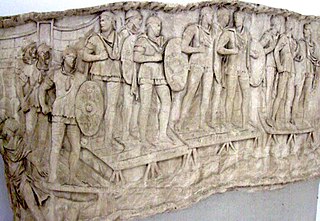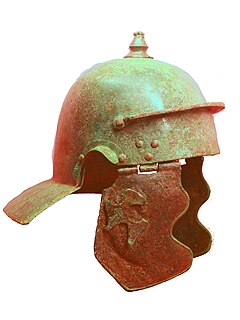
The Auxilia were introduced as non-citizen troops attached to the citizen legions by Augustus after his reorganisation of the Imperial Roman army from 30 BC. By the 2nd century, the Auxilia contained the same number of infantry as the legions and, in addition, provided almost all of the Roman army's cavalry and more specialised troops. The auxilia thus represented three-fifths of Rome's regular land forces at that time. Like their legionary counterparts, auxiliary recruits were mostly volunteers, not conscripts.
Cohors secunda Gallorum veterana equitata was a mixed infantry and cavalry regiment of the Auxilia corps of the Imperial Roman army. It was stationed, in the 2nd and 3rd centuries, in a fort near Hadrian's Wall in Britain.
Cohors secunda Gallorum Dacica equitata was a Roman auxiliary regiment which contained both infantry and cavalry contingents.
Cohors prima Alpinorum peditata was a Roman auxiliary infantry regiment. It was probably raised as one of 4-6 Alpini regiments recruited after the final annexation of the western Alpine regions by emperor Augustus in 15 BC. Alpini was a generic name covering several Celtic-speaking mountain tribes inhabiting the Alps between Italy and Gaul, which were organised as the Tres Alpes provinces. It was originally stationed either on the Rhine or in Illyricum.
Cohors prima Aquitanorum veterana was a Roman auxiliary infantry regiment. It was probably originally raised in Gallia Aquitania in the reign of founder-emperor Augustus after the revolt of the Aquitani was suppressed in 26 BC. Unlike most Gauls, the Aquitani were not Celtic-speaking but spoke Aquitanian, a now extinct non- Indo-European language closely related to Basque.
Cohors prima Aquitanorum was a Roman auxiliary infantry regiment. It was probably originally raised in Gallia Aquitania in the reign of founder-emperor Augustus after the revolt of the Aquitani was suppressed in 26 BC. Unlike most Gauls, the Aquitani were not Celtic-speaking but spoke Aquitanian, a now extinct non Indo-European language closely related to Basque.
Cohors secunda Aquitanorum equitata civium Romanorum was a Roman auxiliary mixed infantry and cavalry regiment. It was probably originally raised in Gallia Aquitania in the reign of founder-emperor Augustus after the revolt of the Aquitani was suppressed in 26 BC. Unlike most Gauls, the Aquitani were not Celtic-speaking but spoke Aquitanian, a now extinct non Indo-European language closely related to Basque. The regiment was also known as cohors II Biturigum. The Bituriges were a Celtic-speaking tribe whose territory was included in Gallia Aquitania. It is believed that when the Aquitani regiments were originally raised, some were made up of mixed Aquitani and Bituriges recruits.
Cohors quarta Aquitanorum equitata civium Romanorum was a Roman auxiliary mixed infantry and cavalry regiment. It was probably originally raised in the Julio-Claudian era, perhaps under Augustus after the subjugation of the Aquitani in 26 BC. Alternatively, it may have been raised in a later levy of Aquitani after 14 AD. Unlike most Gauls, the Aquitani were not Celtic-speaking but spoke Aquitanian, a now extinct non Indo-European language closely related to Basque. Some tribes in Aquitania were Celtic-speaking however, such as the Bituriges.
Cohors prima Alpinorum equitata was a Roman auxiliary mixed infantry and cavalry regiment. Alpini was a generic name denoting several Celtic-speaking mountain tribes inhabiting the Alps between Italy and Gaul, which were organised as the Tres Alpes provinces. The regiment was probably raised as one of 4-6 Alpini units recruited after the final annexation of the western Alpine regions by emperor Augustus in 15 BC.
Cohors secunda Alpinorum equitata was a Roman auxiliary (non-citizen) mixed infantry and cavalry regiment. Alpini was a generic name denoting several Celtic-speaking mountain tribes inhabiting the Alps between Italy and Gaul, which were organised as the Tres Alpes provinces.
Cohors tertia Alpinorum equitata was a Roman auxiliary mixed infantry and cavalry regiment. Alpini was a generic name denoting several Celtic-speaking mountain tribes inhabiting the Alps between Italy and Gaul, which were organised as the Tres Alpes provinces.
Cohors prima Raetorum equitata was a Roman auxiliary mixed infantry and cavalry regiment. It is named after the Raeti nation, which dominated the eponymous province Raetia, which comprised much of modern Switzerland and Germany south of the river Danube. The Raeti originally spoke a non Indo-European language closely related to Etruscan. However, by the time their territory was annexed by Rome under founder-emperor Augustus, they had become largely Celtic-speaking through contact with neighbouring peoples such as the Vindelici. Finally, during the centuries of Roman rule, they became Latin speakers: their distinctive provincial patois survives today in the form of the Rhaeto-Romance languages.

Cohors tertia Delmatarum equitata civium Romanorum pia fidelis, was a Roman auxiliary cohort mixed infantry and cavalry unit.
Cohors quarta Delmatarum was a Roman auxiliary infantry regiment raised in the 1st century AD and continuing to serve into the 2nd century.
Cohors quinta Delmatarum civium Romanorum was a Roman auxiliary infantry regiment. It is named after the Dalmatae, an Illyrian-speaking tribe that inhabited the Adriatic coastal mountain range of the eponymous Dalmatia. The ancient geographer Strabo describes these mountains as extremely rugged, and the Dalmatae as backward and warlike. He claims that they did not use money long after their neighbours adopted it and that they "made war on the Romans for a long time". He also criticises the Dalmatae, a nation of pastoralists, for turning fertile plains into sheep pasture. Indeed, the name of the tribe itself is believed to mean "shepherds", derived from the Illyrian word delme ("sheep"). The final time this people fought against Rome was in the Illyrian revolt of AD 6-9. The revolt was started by Dalmatae auxiliary forces and soon spread all over Dalmatia and Pannonia. The resulting war was described by the Roman writer Suetonius as the most difficult faced by Rome since the Punic Wars two centuries earlier. But after the war, the Dalmatae became a loyal and important source of recruits for the Roman army.
Cohors quinta Delmatarum was a Roman auxiliary infantry unit. It is named after the Dalmatae, an Illyrian-speaking tribe that inhabited the Adriatic coastal mountain range of the eponymous Dalmatia. The ancient geographer Strabo describes these mountains as extremely rugged, and the Dalmatae as backward and warlike. He claims that they did not use money long after their neighbours adopted it and that they "made war on the Romans for a long time". He also criticises the Dalmatae, a nation of pastoralists, for turning fertile plains into sheep pasture. Indeed, the name of the tribe itself is believed to mean "shepherds", derived from the Illyrian word delme ("sheep"). The final time this people fought against Rome was in the Illyrian revolt of 6-9 AD. The revolt was started by Dalmatae auxiliary forces and soon spread all over Dalmatia and Pannonia. The resulting war was described by the Roman writer Suetonius as the most difficult faced by Rome since the Punic Wars two centuries earlier. But after the war, the Dalmatae became a loyal and important source of recruits for the Roman army.

The Alpine regiments of the Roman army were those auxiliary units of the army that were originally raised in the Alpine provinces of the Roman Empire: Tres Alpes, Raetia and Noricum. All these regions were inhabited by predominantly Celtic-speaking tribes. They were annexed, or at least occupied, by the emperor Augustus' forces during the period 25–14 BC. The term "Alpine" is used geographically in this context and does not necessarily imply that the regiments in question were specialised in mountain warfare. However, in the Julio-Claudian period, when the regiments were still largely composed of Alpine recruits, it is likely that they were especially adept at mountain operations.

This article concerns the Roman auxiliary regiments of the Principate period originally recruited in the western Alpine regions of the empire. The cohortes Alpinorum came from Tres Alpes, the three small Roman provinces of the western Alps, Alpes Maritimae, Alpes Cottiae and Alpes Graiae. The cohortes Ligurum were originally raised from the Ligures people of Alpes Maritimae and Liguria regio of NW Italia.
The Cohors I Asturum et Callaecorum was a Roman auxilia unit.



